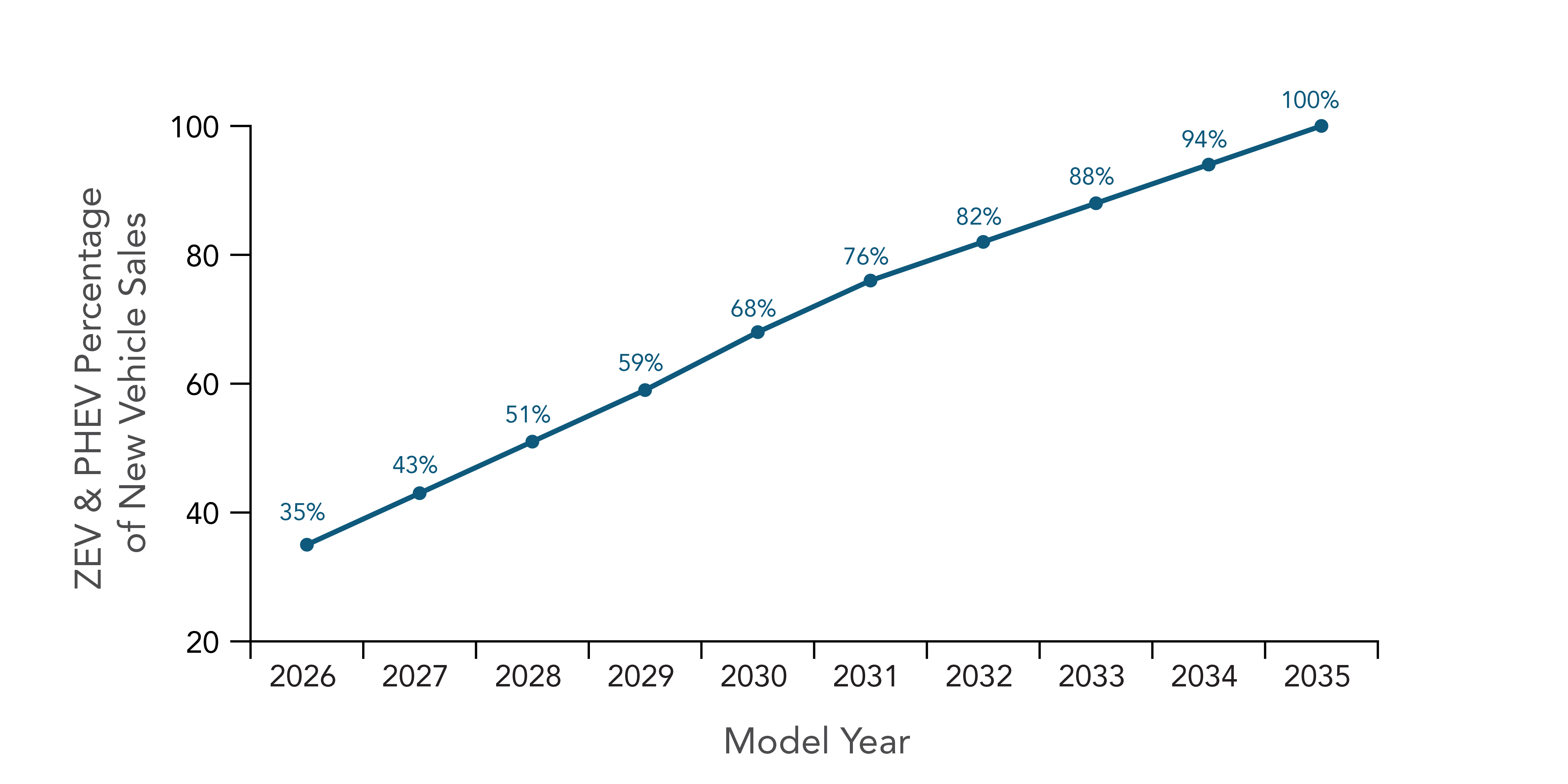On Aug. 25, California regulators approved the Advanced Clean Cars II rule requiring that, by 2035, 100% of new cars and light trucks sold in California must be zero-emission vehicles (ZEVs), including plug-in hybrid electric vehicles (PHEVs).
According to the California Air Resources Board (CARB), the “nation-leading” regulation realizes and codifies the light-duty vehicle goals set out in Gov. Gavin Newsom’s Executive Order N-79-20. The rule applies to automakers (not dealers) and covers only new vehicle sales. It does not impact existing vehicles on the road today, which will still be legal to own and drive.

“Once again California is leading the nation and the world with a regulation that sets ambitious but achievable targets for ZEV sales. Rapidly accelerating the number of ZEVs on our roads and highways will deliver substantial emission and pollution reductions to all Californians, especially for those who live near roadways and suffer from persistent air pollution,” said CARB Chair Liane Randolph.
“The regulation includes ground-breaking strategies to bring ZEVs to more communities and is supported by the governor’s ZEV budget, which provides incentives to make ZEVs available to the widest number of economic groups in California, including low- and moderate-income consumers.”
Other States
Many states and nations have set targets and goals to phase out the sale of internal combustion cars. However, California’s is now the most aggressive.
According to CARB, states that currently follow California’s vehicle rules are expected to adopt these new regulations through their own rulemakings. These states constitute about 40% of the nation’s new car sales. (Washington Gov. Jay Inslee has already announced his state will follow suit.)
Responses
Various environmental groups, including the Sierra Club and Natural Resources Defense Council, hailed the passage of California’s new regulation. However, transportation industry analysts raised concerns about potential roadblocks, including price, materials, and infrastructure.
General Requirements
The new regulation accelerates requirements that automakers deliver an increasing number of zero-emission light-duty vehicles each year beginning in model year 2026. Sales of new ZEVs and PHEVs will start with 35% that year, build to 68% in 2030, and reach 100% in 2035.

Eligibility and Credits
Plug-in hybrid, full battery-electric, and hydrogen fuel cell vehicles count toward an automaker’s requirement. PHEVs must have an all-electric range of at least 50 miles under real-world driving conditions. In addition, automakers will be allowed to meet no more than 20% of their overall ZEV requirement with PHEVs.
Battery-electric and fuel cell vehicles will need a minimum range of 150 miles to qualify under the program and must meet new warranty and durability requirements.
Clean Air and Climate Benefits
Transportation is the single largest source of global warming emissions and air pollution in California. According to CARB, this regulation slashes emissions from cars and light trucks and delivers multiple benefits that grow year by year.
ALSO READ: Get Your Facility Ready for the EV Boom
By 2030, there will be 2.9 million fewer new gas-powered vehicles sold, rising to 9.5 million fewer conventional vehicles by 2035. In 2040, greenhouse gas (GHG) emissions from cars, pickups, and SUVs are cut in half, and from 2026 through 2040 the regulation cuts climate-warming pollution from those vehicles a cumulative total of 395 million metric tons. That is equivalent to avoiding the GHG emissions produced from the combustion of 915 million barrels of petroleum.
According to CARB, the ACC II regulation is a major tool in the state’s target to cut GHG emissions an additional 40% below 1990 levels by 2030, as well as to achieve carbon neutrality by 2045 or sooner.
Increasing Access to ZEVs for All Californians
The governor proposed, and the state legislature has approved, $2.7 billion in fiscal year 2022-23, and $3.9 billion over three years, for investment in ZEV adoption, as well as clean mobility options for California’s most environmentally and economically burdened communities. These programs support the new regulation by increasing access to ZEVs for all Californians, including moderate- and low-income consumers. They include:
- Clean Cars 4 All provides up to $9,500 to low-income drivers who scrap their older vehicles and want to purchase something that runs cleaner.
- The Clean Vehicle Rebate Project provides up to $7,000 for income-qualified drivers to buy or lease a ZEV.
- The Clean Vehicle Assistance Program provides low-income car buyers with special financing and up to $5,000 in down-payment assistance.
The governor’s ZEV budget includes $400 million over three years for the statewide expansion of Clean Cars 4 All and for a suite of clean transportation equity projects. The budget also includes $525 million for the Clean Vehicles Rebate Project. In addition, there is $300 million for more charging infrastructure, especially for those consumers who may not have a garage where they can charge their EV.
Consumer Savings
According to CARB, drivers of full battery-electric vehicles already save money on operation and maintenance compared to cars with internal combustion engines. That’s the result of cheaper fuel—charging at home costs about half as much as gasoline for the same number of miles driven—and battery-electric vehicles can save drivers 40% in maintenance costs.
ALSO READ: Inflation Reduction Act Has Historic Climate and Energy Investments
CARB analysis indicates that battery-electric vehicles are likely to reach cost parity with conventional vehicles by 2030. By 2035, consumers are likely to realize as much as $7,900 in maintenance and operational savings over the first 10 years of ownership. Owners will also see 10-year savings from 2026 model year battery-electric vehicles, though not quite as much.
